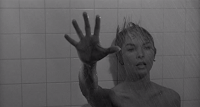Psycho (1960)
The Director; Alfred Hitchcock
Writers; Joseph Stefano (Screenplay) , Robert Bloch (Novel)
Stars/Main cast; Anthony Perkins, Janet Leigh and Vera Miles
-In Psycho, the audience initially think the film is about the $40,000 and the murderer becomes a shock. This shock makes the audience apprehensive for the rest of the film where anything could happen or anyone could be killed at anytime.
Hitchcock thoughts:
the audience know there is a murderer in the house but they don't know when s/he will strike again but to be suspenseful they could know it could happen any minute. Hitchcock stressed that as the apprehension increases there is less and less violence on screens in the movie.
Hitchcock says "thrillers are characterised by fast pacing and frequent action"
Examples of this in Psycho is the shower scene, the car scene or the staircase in the house by the motel.


Norman Bates:

Hitchcock said it is important to avoid cliche and repetition, particularly with regard to character, for example, murderers can be charming and the heroes can be flawed.
In his films, Hitchcock often placed evil in most banal of settings.
Storywise, psycho is not extrodinary, its true brilliance lies in its construction. Hitchcock has developed the film in such a way that it consistently flouts the audience expectations. In this film there are two major surprises. the first one being the shower scene murder and the second one being the final revelation about the mother of Norman.
Devices such as suspense, red herrings and cliffhangers are used extensively.
A viewer who sees the film for the first time without knowing about either will experience the full impact of what Hitchcock intended.
The greatest shock in this film was when the exit of Janet Leigh had occurred. This is doubly unexpected because, to this point, the screenplay had tricked us into accepting Marion as the main character. When she dies, the point of view shifts to Norman Bates which makes the audience puzzled.
In order to keep this crucial aspect of the film secret when Psycho opened in 1960, there were no advanced screenings and no one was admitted to a showing after the feature had started.
The McGuffin
Hitchcock says that this plot device causes the action to happen in the movie. The device usually comes at the beginning of the movie and can also re-appear at the end of the movie. In his thrillers the audience don't really care about the McGuffin. In tis film the McGuffin is Marion stealing the money but the audience are more interested on what will happen to her and where she will go etc.
Whenever anyone speaks about Psycho, The first images that come to mind are those of Janet Leigh being hacked to death in the shower, the scene is so famous that even people who haven'y seen the movie/film are also aware of the famous scene. The shower scene also stands as one of the greatest examples of execution and editing in the history of cinema. Bernard Hermann's discordant music has been used in countless other movies to denote the appearance of a "Psycho". The brilliance of the scene lies in the editing, a frame by frame analysis reveals that Hitchcock left a lot to the audience's imagination.
What we actually see in the shower scene is a knife, blood (which is actually chocolate syrup), water, a woman's nakaed body (with certain parts strategically concealed from the camera), only a brief showing of the blade penetrating the flesh. The fiull horror of the murder is only hinted at on-screen and it takes the power of the viewers's imagination to fill in the blanks.






